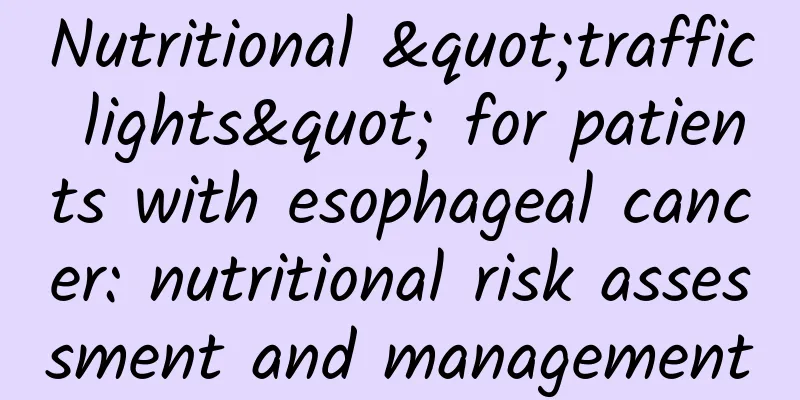Nutritional "traffic lights" for patients with esophageal cancer: nutritional risk assessment and management

|
Author: Wu Yuanzhou Zhujiang Hospital of Southern Medical University Reviewer: Li Hui, deputy chief physician, Zhujiang Hospital, Southern Medical University In the journey of life, health is the most precious wealth of every traveler; however, when the unfortunate disease of esophageal cancer quietly descends, their path forward may be changed. Today, let us explore the nutritional risk assessment and management of esophageal cancer patients and learn how to add strength to the patient's recovery through scientific nutritional intervention. 1. Understanding esophageal cancer: an uninvited guest in the life channel Esophageal cancer, a word that sounds scary, is a member of the digestive tract malignancies that cannot be ignored. It is like an "uninvited guest" that quietly occupies the esophagus, the life passage connecting the mouth and the stomach. As the tumor grows, it not only hinders the smooth passage of food, but may also cause a series of serious nutritional problems. Malnutrition is an important factor that affects the resistance, recovery ability and even treatment effect of esophageal cancer patients. Therefore, for esophageal cancer patients, early detection, scientific treatment, assessment of nutritional risks and emphasis on nutritional management are the keys to recovery. Figure 1 Copyright image, no permission to reprint 2. Nutritional risk screening: the first step to personalized nutritional intervention For patients with esophageal cancer, nutritional risk screening is the primary task to assess whether they need further nutritional intervention. This is like a "physical examination" before a nutritional plan tailored for the patient. Through scientific tools such as the NRS 2002 score sheet, doctors can accurately identify patients who may benefit from nutritional support, especially those at risk of malnutrition. Nutritional risk screening is not only responsible for the patient, but also a guarantee for the treatment effect of esophageal cancer. Figure 2 Copyright image, no permission to reprint III. Comprehensive Nutrition Assessment: In-depth Understanding and Targeted Policy Implementation For those esophageal cancer patients who are screened to have nutritional risks, a comprehensive nutritional assessment (such as the use of PG-SGA) is the next important step. In this process, the doctor will ask the patient in detail about his or her dietary history, weight changes, gastrointestinal symptoms, etc., just like a "careful detective" looking for "clues" that may indicate malnutrition in the patient's daily life. With this information, the doctor can understand the patient's nutritional status more accurately and provide a strong basis for formulating a personalized nutritional treatment plan. Figure 3 Copyright image, no permission to reprint 4. Nutritional therapy: scientific intervention to help recovery The purpose of nutritional therapy is to improve the nutritional status of patients, reduce the incidence of complications during the treatment of esophageal cancer, and thus improve the quality of life of patients. Based on the patient's weight loss, BMI value, biochemical indicators and other factors, the doctor will make a comprehensive consideration and decide whether to start nutritional therapy. In this process, enteral nutrition and parenteral nutrition are two common methods of nutritional support. 1. Enteral nutrition: It is a nutritional support method that provides nutrients needed for metabolism to the body through the gastrointestinal tract through oral or tube feeding. Simply put, this is a method of providing nutrition through the digestive tract, which can make full use of the patient's own digestion and absorption functions. The nutrient solution will slowly enter the patient's stomach through the tube, bringing warmth and strength to the patient's body. This method not only helps maintain intestinal health and immune function, but also improves the patient's treatment compliance and quality of life. 2. Parenteral nutrition: When enteral nutrition is not applicable, parenteral nutrition becomes another "light of life" for patients. Through intravenous infusion, the nutrient solution directly enters the patient's blood circulation to provide the necessary nutritional support for their body. Although this process seems simple, it requires careful management and close monitoring by medical staff to ensure that patients can receive nutritional treatment safely and effectively. 5. Adjustment and optimization: dynamic management to ensure the best results Nutritional therapy is not static, but needs to be adjusted dynamically according to the actual situation of the patient. Doctors will regularly monitor the patient's nutritional status and treatment effects, and adjust the treatment plan in a timely manner based on feedback. This dynamic management model ensures that patients can get the best nutritional support, thereby accelerating the recovery process. At the same time, doctors will also adjust the intake of energy and micronutrients according to the needs of patients to ensure that they can receive comprehensive and balanced nutritional therapy. VI. Nutritional guidance after discharge: Continued care and support for long-term recovery When patients are about to be discharged from the hospital, doctors will not leave them alone. They will provide patients with a detailed nutrition guide and encourage them to continue to follow the nutrition guide after discharge. If necessary, patients can also continue enteral nutrition treatment at home to consolidate the treatment effect and prevent malnutrition. Figure 4 Copyright image, no permission to reprint VII. Conclusion: Protecting life starts with nutrition Nutritional risk assessment and management of esophageal cancer patients is a complex and meticulous task that requires careful management by medical staff and active cooperation from patients. Scientific nutritional intervention and personalized treatment plans can effectively improve the nutritional status of esophageal cancer patients, thereby improving their quality of life and making them more determined and calm on the road to recovery. |
<<: How can I save my dark circles?
>>: Insulin: the blood sugar lowering hero and sugar-friendly partner!
Recommend
Blood pressure, have you paid attention to it?
Hypertension is a systemic disease characterized ...
The past and present of progesterone: Unlocking its life code
Patients often hold test results and ask: Doctor,...
What is the cause of bloody nose during pregnancy?
Key reminder: During pregnancy, a person will hav...
What to do if your nipples are cracked? You should handle it this way
The nipple is the most private and tender part of...
What are the benefits of squatting for women?
What are the benefits of squatting for women? Now...
What is the disease of female urethral granulation?
What kind of disease is female urethral granulati...
How to fish in a black pit after adding potassium permanganate How to fish in a black pit easily
It is not easy to fish in a black pit after addin...
How to care for your pelvic floor muscles after surgery?
Many female friends usually experience pelvic flo...
Olive oil has unimaginable effects on women, but 90% of women don’t know it
Women all like to take care of themselves. Olive ...
Postmenopausal bleeding
Postmenopausal bleeding mainly refers to the mens...
Do women who have a sterilization tend to age faster?
Many people believe that women who have a sterili...
What is the cause of bleeding after menstruation?
Menstruation is something that every girl who ent...
How to double low blood value during pregnancy
If we want to have a healthy baby, we need to pay...
What are the disadvantages of women with hot body?
There are many reasons that can cause people to h...
Be careful! If there are these 3 arrows in your blood routine report, be alert to leukemia!
Last night, I dragged my tired body Getting ready...









